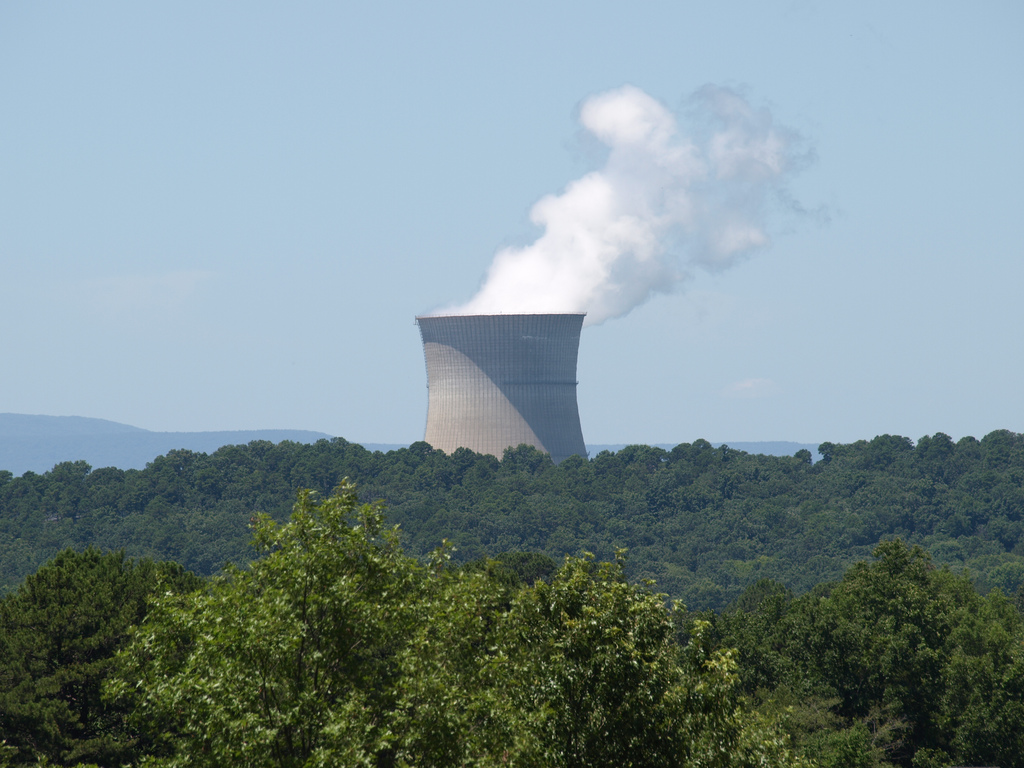On Feb. 16, while President Obama was in Maryland announcing an $8.3 billion taxpayer-backed loan guarantee for Southern Company to build two new nuclear reactors in Georgia, inspectors at the Vermont Yankee reactor were finding dangerously high levels of tritium, a radioactive cancer-causing chemical, in the groundwater near the plant.
The next week, the Vermont state Senate voted overwhelmingly to shut down Vermont Yankee when its current license expires in 2012.
Vermont Gov. Jim Douglas (R) called the timing of the nuclear loan guarantee announcement and the Vermont Senate’s decision “ironic.” More than just some coincidence, though, the Vermont Yankee situation demonstrates that from the mining of uranium ore to the storage of radioactive waste, nuclear reactors remain as dirty, risky, and as costly as they ever were. If President Obama’s recent enthusiasm for nuclear reactors has led you to believe otherwise, you’ve bought in to the administration’s greenwashing of nuclear.
President Obama has justified his proposed $55 billion in taxpayer-backed loan guarantees for new nuclear reactors by misrepresenting nuclear reactors as the largest “carbon-free” energy source in the United States. That’s like saying McDonald’s should be put in charge of a nationwide obesity campaign because it’s the largest restaurant in the U.S. that sells salads.
The argument that nuclear is “carbon-free” conveniently omits the entire process of mining uranium, which produces greenhouse gases, along with other pollutants. In Virginia, where a study has just been commissioned to determine its safety, uranium is mined in open pits. This destroys topsoil and increases runoff, which contaminates drinking water with cancer-causing toxins.
The uranium-enrichment process also emits greenhouse gases and is highly wasteful. Eighty percent of the ore that goes through the enrichment process ends up as waste. And this is to say nothing of the lye, sulfuric acid, and other caustic agents that must be used to turn the uranium into reactor-ready fuel.
While on the surface, the steam billowing from the cooling tower of a nuclear reactor is less harmful than the toxic smoke that spews from a coal plant, nuclear reactors still create byproducts that are dangerous to human health and welfare. There’s also the huge problem of radioactive nuclear waste, which can stay hot for hundreds of thousands of years. Storing the radioactive waste isn’t just a security threat; there’s potential for radioactive chemicals to leak, as they are in Vermont and at other aging reactors around the country.
Spent radioactive waste continues to sit at reactor sites and wait for a scientific breakthrough that is 50 years overdue. But a long-term waste storage solution doesn’t exist. The Yucca Mountain facility, the government’s radioactive waste repository project in Nevada, was marked by billions of wasted dollars, numerous legal challenges, and fundamental infeasibility. President Obama recognized Yucca Mountain’s failure and cut the funding for it in 2009. Secretary of Energy Steven Chu followed up by issuing a request last week to revoke Yucca Mountain’s application to be licensed as a waste repository.
In Maryland last month, President Obama told us the United States needs to build new nuclear reactors to keep up with France’s nuclear investments. But France has had its own problems with radioactive waste contamination. The government has had to close down entire rivers because of leaks.
In the same speech, President Obama also used China’s nuclear growth to greenwash his administration’s push for more nuclear reactors. But his argument doesn’t stand up. The United States already gets a greater percentage of its energy from nuclear reactors than China will after it reaches its target for nuclear growth, and China has pledged to invest even more toward increasing its solar and wind output. The goal of the United States should not be to build more nuclear reactors, but to make them irrelevant through our own investment in truly clean, renewable sources of energy.
In another inapt comparison, President Obama contrasted the emissions from a nuclear reactor with the emissions from a coal plant. But that false dichotomy ignores the cleaner and safer forms of renewable energy that exist and will do more to reduce greenhouse gases. Worldwide, renewables have actually outpaced nuclear reactors in energy capacity and fossil fuels in investment.
The $55 billion in taxpayer money the Obama administration wants to risk on more nuclear reactors would produce a far greater return if spent on truly clean, renewable energy. Building new nuclear reactors would be the most ineffectual method to reducing greenhouse gases, whereas building more wind turbines or installing more photovoltaic solar panels would not only do a better job at mitigating climate change, but would create more jobs. President Obama’s nuclear industry bailout instead pushes us back to the energy future of the 1950s and gives cover to the nuclear industry to continue to be lax on safety enforcement and lethargic in technological advancement.
President Obama has said that “environmentalists and entrepreneurs” should no longer retread the same arguments about nuclear energy. But Vermont Yankee shows us that there’s nothing new in nuclear that merits revisiting; clean and safe nuclear energy remains an “Atoms for Peace” pipedream. There may be a shiny green coat of paint on the cooling tower, but dangerous chemicals still leak from the pipes.



